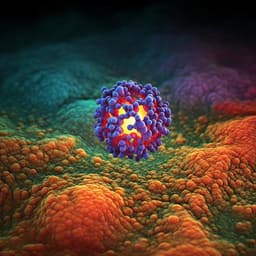Introduction
Liposomes, composed of lipid bilayers containing phospholipids and cholesterol (Chol), are widely used for drug delivery due to their biocompatibility and biodegradability. While FDA-approved liposomal nanotherapeutics improve pharmacokinetics and reduce side effects, therapeutic efficacy often remains suboptimal. Chol is crucial for membrane stability, reducing fluidity and permeability. However, under physiological conditions, Chol readily transfers between biomembranes and lipoproteins, destabilizing liposomes and causing premature drug leakage. This leads to rapid blood clearance and reduced therapeutic efficacy. To overcome this limitation, an improved lipid bilayer is needed to enhance drug packaging and delivery. Previous research explored sterol-modified lysophospholipids (SMLs) and Chol derivatives, but these approaches yielded limited improvements in therapeutic efficacy. This study proposes to engineer an improved lipid bilayer by covalently conjugating Chol to sphingomyelin (SM), a double aliphatic chain phospholipid present in cell membranes. SM was selected due to its natural occurrence in mammalian cell membranes, the presence of a hydroxyl group for Chol conjugation, and its role in liposomal vincristine formulations. The researchers hypothesized that SM-Chol would enhance bilayer cohesion, improving drug encapsulation and delivery, offering advantages over SMLs and conventional phospholipid/Chol systems.
Literature Review
Several studies have investigated strategies to improve liposomal drug delivery by modifying cholesterol. Dr. Francis C. Szoka, Jr.’s team developed sterol-modified lysophospholipids (SMLs), covalently attaching Chol to lysophospholipids. While these showed reduced Chol exchange and leakage, their therapeutic efficacy was limited. Sergelius et al. created N-cholesteryl sphingomyelin, enhancing bilayer order and resistance to detergent solubilization. Other researchers have modified Chol with cationic groups for gene therapy or with targeting peptides to improve delivery efficiency. However, these modifications didn't consistently improve bilayer physicochemical properties and might compromise stability. The current study builds upon these efforts by focusing on covalently linking Chol to SM, a double-chain phospholipid abundant in cell membranes, to address the limitations of previous approaches and better mimic cellular membrane composition. This strategy aimed to improve bilayer stability, reduce permeability, and allow for controlled drug release by employing various stimuli-responsive bonds in the linker between SM and Chol.
Methodology
The researchers designed and synthesized five SM-Chol conjugates with different linker chemistries: carbonate ester, ester, glycine, disulfide (SM-CSS-Chol), and thioketal bonds. These were characterized using 1H NMR, 13C NMR, and ESI-MS. Liposomes (Lipo) were formed using SM-Chol and compared to conventional phospholipids/Chol and SMLs. Dynamic light scattering (DLS) was used to assess size, zeta potential, and stability. Calcein release kinetics were measured in PBS and glutathione (GSH) to evaluate payload release and bilayer stability. Osmotic stress-induced leakage was evaluated in various solutions. Cholesterol exchange rates were determined. Differential scanning calorimetry (DSC) analyzed thermotropic phase transition behavior. Atomic force microscopy (AFM) assessed bilayer rigidity. To evaluate in vivo efficacy, the maximum tolerated dose (MTD) of vincristine (VCR) was determined in mice. Pharmacokinetics and biodistribution studies were conducted in various cancer models (MC38 colorectal cancer, SU-DHL-4 diffuse large B-cell lymphoma, KPC-Luc pancreatic ductal adenocarcinoma, 4T1-Luc2 triple-negative breast cancer) and a lung inflammation model. The therapeutic efficacy of IRI, DOX, and DEX were investigated. Finally, the gene delivery efficiency of siRNA targeting P-glycoprotein was evaluated in a CT26 colorectal cancer model using an ionizable lipid and various lipid formulations. Statistical analysis included t-tests and ANOVA, as appropriate.
Key Findings
The study demonstrated that SM-Chol conjugates formed stable liposomes with similar size and zeta potential to SM/Chol liposomes. SM-CSS-Chol, with a disulfide bond and longer linker, exhibited the best performance in blocking Chol transfer and preventing payload leakage compared to other SM-Chol conjugates, SMLs, and conventional phospholipid/Chol liposomes. In a healthy mouse model, VCR/Lipo-SM-CSS-Chol increased the maximum tolerated dose of VCR compared to free VCR and other liposomal formulations without inducing systemic toxicities. In a SU-DHL-4 lymphoma xenograft model, VCR/Lipo-SM-CSS-Chol improved pharmacokinetics, enhanced tumor delivery efficiency, showed significant tumor growth inhibition, and prolonged mice survival compared to other liposomal formulations. In KPC-Luc pancreatic cancer and 4T1-Luc2 breast cancer models, IRI/Lipo-SM-CSS-Chol and DOX/Lipo-SM-CSS-Chol significantly improved therapeutic outcomes compared to respective FDA-approved liposomal nanotherapeutics (Onivyde and Doxil) and other liposomal formulations. In a lung inflammation model, DEX/Lipo-SM-CSS-Chol demonstrated superior anti-inflammatory effects compared to free DEX and other liposomal formulations. In a CT26 colorectal cancer model, siRNA/LNP-DMA/SM-CSS-Chol demonstrated improved gene silencing efficiency compared to siRNA/LNP using SM/Chol or PChcPC. Combining IRI/Lipo-SM-CSS-Chol with siRNA/LNP-DMA/SM-CSS-Chol further enhanced antitumor efficacy by increasing intratumoral drug uptake.
Discussion
The findings demonstrate that covalently conjugating Chol to SM significantly improves liposomal drug delivery by preventing Chol exchange and enhancing membrane stability. The superior performance of SM-CSS-Chol highlights the importance of linker chemistry in controlling drug release and maximizing therapeutic efficacy. The improved pharmacokinetics and tumor delivery efficiency observed with SM-CSS-Chol are crucial for enhancing therapeutic outcomes in various cancer types. The ability of SM-Chol to enhance the delivery of both small molecules and nucleic acids suggests its potential as a universal platform for various therapeutic applications. The findings significantly advance the field of liposomal drug delivery by providing a novel strategy to overcome the limitations of cholesterol exchange.
Conclusion
This study successfully developed a cholesterol-modified sphingomyelin (SM-Chol) chimeric lipid bilayer that substantially improves therapeutic delivery. The SM-CSS-Chol formulation demonstrated superior performance across multiple drug types and cancer models, highlighting its potential as a versatile platform for drug and gene delivery. Future studies should investigate the application of SM-Chol in other disease models and explore the possibility of further optimizing the linker chemistry for even better therapeutic efficacy. Clinical translation of SM-Chol-based formulations is a promising next step.
Limitations
The study primarily used murine models. Further research is needed to validate these findings in human clinical trials. While the study demonstrated improved therapeutic efficacy, long-term toxicity studies are needed to fully assess the safety profile of SM-Chol formulations. The study focused on a limited number of drugs and siRNA. Additional research is needed to determine the applicability of this platform to a wider range of therapeutic agents.
Related Publications
Explore these studies to deepen your understanding of the subject.







